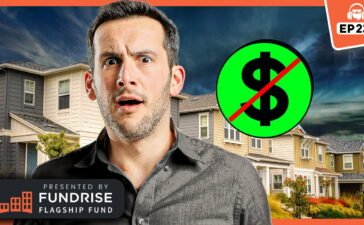Yes, Tiny Homes Could Be the Most Cost-Effective Way to Cash Flow Right Now—Here’s Why

Bigger is not always better, especially when it comes to homes and mortgage payments. High interest rates and soaring house prices have made developers, homeowners, and investors consider going smaller to make big money.
“The monthly payment matters more than anything else, and builders have responded with smaller, more efficient homes,” John Burns, chief executive with Irvine, California-based firm John Burns Research and Consulting, told the New York Times.
The same article reveals that the median new U.S. home peaked at around 2,500 square feet in 2015. New homes have since shed about 200 square feet as costs rose, urban living boomed, and families got smaller. The current affordability crisis has shrunk the envelope even more, and many real estate investors have realized that they need to downsize the square footage of their investment homes to cash flow.
What Is a Tiny Home?
But first, what is the definition of a tiny home?
A tiny home is generally a dwelling that measures less than 400 square feet. Many are constructed on trailers, which makes them mobile. However, accessory dwelling units (ADUs) and other small dwellings, such as cottages and in-law suites, can also be classified as tiny homes if they fit the rough dimensions.
The Cost of Building a Tiny Home
On average, building a tiny home costs a minimum of $20,000, which is around 4% of the average U.S. home sale price. Custom-built homes with add-ons can double the price of a tiny home, and a home on wheels usually costs between $60,000 and $80,000.
It’s worth noting that if your tiny home is mobile and located in your primary residence’s garden, you will not need to pay property taxes. If it is on a foundation on a separate parcel of land, you will need to factor in the cost of buying the land and property taxes into your expenses.
ROI and Cash Flow
With an outlay of over $100,000, what type of cash flow can you earn on a tiny home used for an investment? Much of it depends on your home’s location. If it is by a beach in a popular tourist destination, near a lake in a picturesque countryside, or in a major city in a home’s back garden, expect to earn high rents.
According to short-term rental analytics site AirDNA, Getaway, a start-up that rents tiny prefab cabins for $129 to $299 a night, raised $41.7 million in 2021. The cost of each cabin was around $40,000 per Airbnb investment.
TechCrunch revealed that Gateway experienced a nearly 100% occupancy rate for their properties. Rounding off the numbers for convenience, assuming each home was rented for $200/night for 300 nights per year, amounts to a total yearly income of $60,000 per year, which would pay off the cost of the cabin in its first year, with $20,000 left over for additional expenses.
Airbnb co-founder Joe Gebbia started Samara in 2022, a company specializing in prefab ADUs. This further points to the growing popularity of tiny houses as investments. By placing an ADU in their backyard, homeowners can forgo the expense of real estate taxes and earn extra money without having strangers in their living space.
Cities Are Getting on Board the Tiny House Explosion
Expensive cities see ADUs as a way to alleviate their housing crises. Although prohibitive short-term rental laws mean they cannot be used in places such as San Francisco, Los Angeles, and New York for less than 30 days, they are a much-needed housing pressure valve for conventional yearly lease tenants or for homeowners in need of more space.
ADUs Could Be Great for Homeowners in Pricey Cities
California passed a series of laws in 2016 to make ADUs easier to build in the state by overriding local zoning and land use restrictions, enabling backyard homes. Los Angeles also tried to spur the construction of ADUs by experimenting with new financing methods and other solutions. New York City will help finance the construction of ADUs under its Plus One ADU program with no- or low-interest loans. Although tiny homes on wheels are illegal in New York City, ADUs, which occupy backyards on already-owned homes, are allowed.
It could be a fantastic way for homeowners to bring in extra income in a high-cost rental city. As NYC’s Housing Preservation & Development website states: “ADUs can serve a number of different purposes, providing housing to family members or serving as an added source of income for household expenses by renting an additional unit.”
In major cities, however, the cost of constructing an ADU increases dramatically compared to that of a tiny home. For example, Samara’s studio starts at $289,000, and the one-bedroom unit starts at $329,000, including installation costs.
Multiple states have tiny home-friendly development laws, including:
- California
- Florida
- Georgia
- Kansas
- North Carolina
- Oregon
- Texas
However, tiny homes are illegal in the following states:
- Alaska
- Iowa
- Louisiana
- New Jersey
- New York
- North Dakota
- West Virginia
- Wisconsin
Thinking Big
If you’re thinking about instantly scaling your tiny home business, mobile home parks and trailer parks are good places to start because the grounds are already zoned for and equipped with amenities for small homes. It’s fairly straightforward to buy plots of land and replace existing trailers with tiny houses, which are modern, sustainable, and more livable than trailer homes.
Final Thoughts
Whether you want to downsize your living expenses to reach financial freedom sooner by moving into a tiny home, turbo boost your investment capital by buying tiny homes for cash, or getting lower mortgages for multiple properties, the numbers don’t lie: Tiny homes are moneymakers.
Appreciation is often the big question leveled at tiny homes. Clearly, mobile tiny homes probably depreciate rather than appreciate and do not carry the same tax advantages as tiny homes that are built on a foundation on separate parcels of land. For the latter, as with larger homes, the same holds true for tiny homes. The more valuable the land and the greater the number of improvements you have made on your tiny home, the greater the appreciation will likely be.
Get the Best Loan Today
Find trusted, investor-friendly lenders who specialize in your strategy.

Ready to succeed in real estate investing? Create a free BiggerPockets account to learn about investment strategies; ask questions and get answers from our community of +2 million members; connect with investor-friendly agents; and so much more.
Note By BiggerPockets: These are opinions written by the author and do not necessarily represent the opinions of BiggerPockets.









